| Navigation |
|
|
|
|
|
|
|
|
|
|
|
|
|
|
|
|
|
|
|
|
|
|
|
|
|
|
|
|
|
|
|
|
|
|
|
|
|
|
|
|
|
|
|
|

|
|
|
|
| |
What's the true story on South American Nazis?
January 30, 2004
Dear Cecil:
What's the true story on South American Nazis? After World War II why would countries like Argentina and Paraguay want them?
David Storms
Come now. After the war Argentina and Paraguay were run for years by nationalist strongmen, Juan Peron and Alfredo Stroessner respectively, who liked to strut around in military regalia and brutalize dissidents. Argentina had remained officially neutral until early 1945, when economic pressure forced it to throw in with the Allies, but until that point was in intimate contact with Hitler's regime and the fascist Franco government in Spain. Postwar Brazil was still fascist-friendly, a legacy of deposed dictator Getulio Vargas. Surely it's no surprise that the leaders of these countries nurtured fraternal feelings for fleeing Nazis. I might also point out that not all fugitives from the Third Reich ended up in South America--quite a few are said to have headed for Spain or the Middle East, and the U.S. imported a crowd of Nazi rocket scientists during Operation Paperclip. That said, the true story of how war criminals like Adolf Eichmann and Josef Mengele wound up in the land of the gauchos has never been fully told, and even now it's difficult to separate fact from fiction. Leading candidates for chief enabler of the great escape include: Part of the popular consciousness ever since Frederick Forsyth's best-selling 1972 novel The Odessa File, this secret group (the name is an acronym for Organization der ehemaligen SS-Angehörigen, "Organization of Former SS Members") supposedly used stashed war booty and connections in high places to spirit Nazi big shots out of reach of the Allies. Nazi hunter Simon Wiesenthal says he first heard about Odessa during the Nuremberg trials, and in his 1989 book Justice, Not Vengeance he seems convinced it exists, or rather existed. He offers little evidence, though, and others have their doubts. Even some believers say the organization was amateurish and short-lived. The claim that members of the Catholic hierarchy were instrumental in obtaining documents, cash, and safe passage for many escaping Nazis is only barely scandalous these days. The benign view is that individual clerics acted out of humanitarian concern, believing they were aiding refugees from postwar communist persecution, and were unaware of their charges' sordid pasts. Others say the Vatican knew quite well what was going on but wanted former Nazis as allies in its struggle against the reds. A figure commonly named in this context is Alois Hudal, an openly pro-Nazi German bishop in Rome who is said to have helped engineer the escapes of dozens if not hundreds of Nazis--including Eichmann, who was living in Argentina when the Mossad caught him in 1960, and Franz Stangl, commandant of the Treblinka death camp, who ultimately made his way to Brazil and was captured there in 1967.
All of the above plus Peron. Argentine journalist Uki Goñi, in The Real Odessa: Smuggling the Nazis to Peron's Argentina (2002), offers what amounts to a synthesis of earlier theories. The "real Odessa," he says, consisted of about a dozen energetic ex-Nazis and Nazi collaborators from several nations, including a few wanted war criminals, working in concert with the Peron regime and sympathetic Catholic officials in both Europe and Argentina. Goñi makes a plausible case that the cabal, which was organized in Buenos Aires following Peron's election as Argentina's president in 1946, orchestrated the emigration of hundreds, perhaps thousands of Nazis and other unsavory types to the country in the late 1940s and early 1950s. (He also claims that the cabal was based at the presidential palace, and that many of its members were given important jobs in Peron's government.) The old Nazis made frequent trips to Europe to troll for more fugitives; some war criminals had to be smuggled out, but in other cases countries were glad to unload their troublesome Nazi refugees. Visas and landing permits were handed out freely, the chief concern being that no communists or Jews be allowed in by mistake. How many ex-Nazis made it to Argentina is not known. Goñi says he identified 300 during six years of research, and it's easy to believe there were many more. It's a lot to swallow, no question, and notwithstanding his 591 footnotes Goñi concedes that many key Argentine records that would've corroborated his story have been destroyed. Still, he avoids the overheated claims of other writers, and the plain fact is that all those Nazis didn't wind up in South America by coincidence--they were going where they were welcome. As for the details? Given the current worldwide consensus that Nazis represent the ultimate human evil (and the resulting disinclination of officials in Argentina and elsewhere to come clean), Goñi's book may be as close as we'll get to the truth.
Cecil Adams
Odessa and Nazis in Latin Amerika
From The Straight Dope syndicated column’s website
As early as 1947, Simon Wiesenthal began to identify escape routes used by Nazis to escape from Germany. The main route he discovered was from the small Bavarian town of Memmingen to Innsbruck, Austria. From there, it was possible to cross into Italy over the Brenner pass. Wiesenthal later learned the Nazis referred to this as the "B-B" route, from Bremen in Germany to the Italian port of Bari. He also knew that the fugitives had little or no difficulty obtaining false papers and seemed to have enough money available in their new home to establish comfortable new lives. Wiesenthal concluded a secret organization with substantial resources had to be involved in helping fugitive Nazis. The seeds of that project were planted before World War II ended. By 1944 it was clear that the fortunes of war had turned against Nazi Germany. Many Germans began to anticipate defeat and to plan for that eventuality. On August 10, 1944, a secret meeting of top German industrialists and bankers was held at the Maison Rouge hotel in Strasbourg to devise a means of insuring a secure future for Nazis. Among those attending were coal tycoon Emil Kirdorf, Georg von Schnitzler of IG Farben, Gustav Krupp von Bohlen und Halbach, steel magnate, Fritz Thyssen, and banker Kurt von Schroeder.
The Nazis recognized that Germany's assets would fall into the hands of the rapidly approaching enemy if they were not transferred and hidden. The nation's wealth, much of it acquired through the plunder of the nations it invaded and the people the Nazis murdered, had to be transferred so they would be out of judicial reach, but accessible to fund a future movement to resurrect the party and build a new Reich. Leading Nazi officials also feared retribution from the Allies and, rather than face likely punishment for their war crimes, they decided to seek safe havens outside Germany, and beyond the reach of justice. According to the protocol from the meeting: The party leadership is aware that, following the defeat of Germany, some of her best-known leaders may have to face trial as war criminals. Steps have therefore been taken to lodge the less prominent party leaders as "technical experts" in various German enterprises. The party is prepared to lend large sums of money to industrialists to enable every one of them to set up a secret post-war organization abroad, but as collateral it demands that the industrialists make available to it exisitng resources abroad, so that a strong German Reich may reemerge after the defeat.....
The outcome of the meeting in Strasbourg was the genesis of an organization; one well-financed and well-organised, with the express purpose of helping fleeing Nazis escape justice. This organization was called the "Organization Der Ehemaligen SS-Angehörigen" ( "The Organization of former SS members) — better known as Odessa.
Wiesenthal learned of Odessa accidentally during conversations with a former member of German counter-espionage who he met during the Nuremberg trials.The source said the organization was set up in 1946 after many Nazis already had been imprisoned. Those in jail contacted friends and aid committees that had been established to promote the welfare of prisoners. The assistance often went beyond humanitarian aid to abetting their escape. In short order, Odessa, built a large and reliable network geared to achieve its ends, and began operations. Routes were mapped and contacts were established. Influential Nazis vanished as they were secretly ushered out of Germany and assisted in starting new lives under false names in foreign countries. At the end of the war, only a handful of high-ranking Nazi officials stood trial. Many who were guilty of war crimes escaped with the help of Odessa. Some war criminals remained in Germany and took on new identities, managing to get themselves smuggled out of Germany and to freedom during the chaos at the end of hostilities. An underground network called "Die Spinne" (The Spider) supplied false papers and passports, safe houses, and contacts that could smuggle war criminals across the un-patrolled Swiss borders. Once into Switzerland, they moved on quickly to Italy, using what some called "The Monastery Route." Roman Catholic priests, especially Franciscans, helped Odessa move fugitives from one monastery to the next until they reached Rome. According to Wiesenthal, one Franciscan monastery, Via Sicilia in Rome, was virtually a transit station for Nazis, an arrangement made possible by a bishop from Graz named Alois Hudal.
Wiesenthal speculates that the motive for most of the priests was what he viewed as a misguided notion of Christian charity. Once in Italy, the fugitives were out of danger, and many then dispersed around the globe. Some countries may not have known about their new immigrants' pasts, but many did and chose to look the other way. Others, including the United States, looked to exploit the knowledge of Nazis. Fascist countries, such as Spain under Franco, as well as those in South America, became safe havens. The establishment of the state of Israel after World War II led some Arab nations to welcome Nazis who shared their hatred of the Jews in the hope they would use their experise in areas such as rocketry to tilt the balance in the Arab-Israeli conflict.
Adolf Eichmann was one of the most notorious of the Nazis to escape Germany thanks to ODESSA, but he was eventually captured in South America by Israeli Intelligence agents and brought back to Israel to stand trial for his crimes against the Jewish people.
enc.slider.com/Enc/ODESSA
www.search.com/reference/Odessa
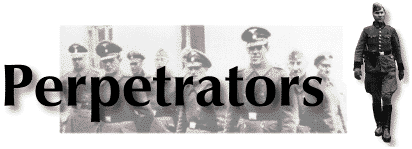
The National Socialist German Workers' Party or NSDAP  , known as the Nazi Party, controlled Germany from 1933 to 45. Nazis labeled and isolated Jews, Gypsies, Slavs, homosexuals, political prisoners, and the mentally and physically disabled. Some were passively killed by starvation and widespread disease. Millions were murdered in attacks by the Gestapo , known as the Nazi Party, controlled Germany from 1933 to 45. Nazis labeled and isolated Jews, Gypsies, Slavs, homosexuals, political prisoners, and the mentally and physically disabled. Some were passively killed by starvation and widespread disease. Millions were murdered in attacks by the Gestapo  , the SA , the SA  , and the SS , and the SS  , in mass killings of the Einsatzgruppen, , in mass killings of the Einsatzgruppen, in and around Nazi concentration, and later death camps. Although Adolf Hitler is often perceived as the chief perpetrator, there were others. Perpetrators were Nazi party leaders, bankers, professors, military officials, doctors, journalists, engineers, judges, authors, lawyers, salesmen, police, and civil servants. Perpetrators committed crimes against Jews and other undesirables for many reasons. They wanted power. They believed in an ideology of racial cleansing. They profited financially, displaced their anger from their own failures, or were perhaps "following orders." in and around Nazi concentration, and later death camps. Although Adolf Hitler is often perceived as the chief perpetrator, there were others. Perpetrators were Nazi party leaders, bankers, professors, military officials, doctors, journalists, engineers, judges, authors, lawyers, salesmen, police, and civil servants. Perpetrators committed crimes against Jews and other undesirables for many reasons. They wanted power. They believed in an ideology of racial cleansing. They profited financially, displaced their anger from their own failures, or were perhaps "following orders."
Hitler's war against Germany's domestic enemies was waged with court decrees, a continuous flow of propaganda, and ever present violence.
Legal policies
Nazis began to whittle away at the rights of Jews and other party enemies soon after Hitler became Chancellor in January of 1933. One example is the treatment of German Jews. A series of laws were created banning "non-Aryans" from civil service, the legal, medical, and dental professions, teaching positions, cultural and entertainment enterprises, and the press. At the 1935 party rally, the Nuremberg Laws were announced, completing the disenfranchisement of the Jews. Jews no longer were German citizens; they were subjects. They were forbidden to marry Aryans and forbidden to fly the Reich and national flags. Jews were separated politically, socially, and legally from the Germans.
The full Nuremberg Laws are listed
A third phase of restricting Jewish rights took place in 1938-39. In July 1938, Jews were required to carry identification cards. Later, Jewish children were banned from school and curfews were instituted. Jews were also excluded from businesses, parks, resorts, and forests. A one billion mark penalty was levied against the Jews for "the hostility of Jewry toward the German people and Reich...."
 The list of discriminatory decrees against Jews as presented at the Nuremberg Trials. The list of discriminatory decrees against Jews as presented at the Nuremberg Trials.
Propaganda
Propaganda employs techniques which assume that the masses are not individuals capable of forming their own opinions. Propaganda relies on emotion rather than on logic, concentrates on a few points which are presented in simple terms, and then hammers those points repeatedly.
Adolf Hitler helped establish the Nazi party in 1920 and was the propaganda director of the Party before becoming its leader. In his book, Mein Kampf (My Struggle), written in 1924, Hitler wrote: The function of propaganda is to attract supporters, the function of organization to win members... Propaganda works on the general public from the standpoint of an idea and makes them ripe for the victory of this idea....Until 1929, the technical equipment available to the Nazi propagandists was rather primitive, so propaganda trucks carried posters and people shouting slogans. As microphones, loudspeakers, and other mass media developed, so did the sophistication of Nazi propaganda.
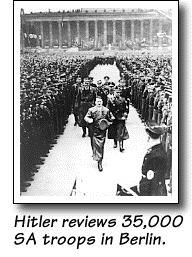 Hitler, a highly skilled orator, spoke at a number of mass rallies. These mass meetings created a sense of community, kept emotional levels high, and were a psychologically fertile environment in which to deliver propaganda. Rallies often took place in the evening when Hitler thought that people were most suggestible and least resistant. Carefully timed stage effects including: marching music, spotlights, torchlight processions, parades, flags fluttering, shouts of "Heil!," and impassioned oratory created the feeling of national unity, strength, and purpose. Hitler, a highly skilled orator, spoke at a number of mass rallies. These mass meetings created a sense of community, kept emotional levels high, and were a psychologically fertile environment in which to deliver propaganda. Rallies often took place in the evening when Hitler thought that people were most suggestible and least resistant. Carefully timed stage effects including: marching music, spotlights, torchlight processions, parades, flags fluttering, shouts of "Heil!," and impassioned oratory created the feeling of national unity, strength, and purpose.
 A series of quotes from Mein Kampf describes in greater depth Hitler's attitude about propaganda. Propaganda was used throughout the Nazi Party's lifetime, in its rise to power and while Hitler was Führer A series of quotes from Mein Kampf describes in greater depth Hitler's attitude about propaganda. Propaganda was used throughout the Nazi Party's lifetime, in its rise to power and while Hitler was Führer  . Several weeks after Hitler was named Chancellor, Joseph Goebbels . Several weeks after Hitler was named Chancellor, Joseph Goebbels was appointed the Minister of People's Enlightenment and Propaganda. He had total control of radio, press, publishing, cinema, and the other arts. The weekly newspaper, Der Stürmer, was appointed the Minister of People's Enlightenment and Propaganda. He had total control of radio, press, publishing, cinema, and the other arts. The weekly newspaper, Der Stürmer, was an antisemitic newspaper with a circulation of around 500,000 at its peak in 1927. Julius Streicher, a friend of Hitler, was the founder of the antisemitic journal. was an antisemitic newspaper with a circulation of around 500,000 at its peak in 1927. Julius Streicher, a friend of Hitler, was the founder of the antisemitic journal.  Samples of Julius Streicher's antisemitic remarks. Samples of Julius Streicher's antisemitic remarks. A brief introduction to Der Stürmer from About.com. A brief introduction to Der Stürmer from About.com. Photographs of many examples of Nazi propaganda are also available at the Wiesenthal Center site. Photographs of many examples of Nazi propaganda are also available at the Wiesenthal Center site.
Violence--terror and death
Hitler's philosophy about terror was clear-cut: We must be ruthless...Only thus shall we purge our people of their softness...and their degenerate delight in beer-swilling...I don't want the concentration camps transformed into penitentiaries. Terror is the most effective political instrument...It is my duty to make use of every means of training the German people to cruelty, and to prepare them for war...There must be no weakness or tenderness.
The SS (Schutzstaffelnor guard squadrons), the SA (Sturmabteilungor storm troops), the SD (Sicherheitsdienst des Reichsführers-SS or security service of the SS), and the Gestapo (Geheime Staats Polizeior Secret State Police) were all Nazi instruments of terror.
The SA was founded in 1921 as the Nazi Party militia. It lured new recruits with promises of adventure: participating in parades and secret meetings, painting slogans on buildings, fighting with opponents, and wearing the Brown Shirt uniforms. The SA recruited 15,000 members by 1923, and by the end of 1933, the SA was four-and-a-half million men strong. The SS began in 1925 as a small personal guard unit to protect Hitler and other party leaders. It developed into the elite corps, the Black Shirts, under the direction of Heinrich Himmler. There were about 100,000 members in 1933. A power struggle occurred in 1934, called the "Night of the Long Knives," between the SA and the SS. The SS won. Himmler was made chief of the German police as well as the head of the SS, able to act within the law as head of the police and outside the law as head of the SS. Germany was truly a police state in which almost any act of terror could now be interpreted as legal. The German people were in the hands of the police, the police were in the hands of the Nazi Party, and the Party was in the hands of a ring of evil men....--Prosecutor Jackson's Address to the International Military Tribunal.
Himmler established the Nazi Party's intelligence service in 1931, appointing Reinhard Heydrich as its chief. This section of the SS was created to uncover the Party's enemies and keep them under surveillance. After the outbreak of the war, the SD was assigned operational tasks, joined the Einsatzgruppen,and played a central role in organizing and implementing the "Final Solution."
The Gestapo was composed of professional police agents, unlike the SS or SA. The Gestapo, in addition to their own agents, had block wardens, who kept close watch on the tenants of their block. The Gestapo was everywhere. Even a hint of criticism of the National Socialist Regime could result in arrest. The Nazi party military and police agencies wielded their power violently, leaving a wake of terror and fatalities. Joseph Goebbels and Reinhard Heydrich orchestrated a night of terror in Germany, destroying synagogues, smashing windows of Jewish businesses and homes, looting, physically beating Jews, and arresting thousands of Jews who were then sent to concentration camps. On November 9 and 10, 1938, Kristallnacht,or "The Night of Broken Glass," was a turning point in the escalation of terror against Jews. A series of photographs of the destruction of Kristallnacht. A series of photographs of the destruction of Kristallnacht.
 Kristallnachtis explained in greater detail and the origin of the term is discussed. Kristallnachtis explained in greater detail and the origin of the term is discussed. 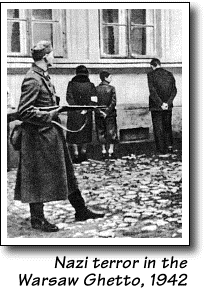 Concentration camps were a part of the perpetrators' systematic reign of terror. The SA and the SS units, during the first months following the Nazi seizure of power, established the camp at Dachau in March, 1933. Initially, Communists, Socialists, labor leaders, and other political opponents were the prisoners. Jews and homosexuals were sent next. By 1934, a unit of the SS, named the Death's Head Formations, was in charge of all the concentration camps. Prisoners were starved, forced into labor, tortured, and sometimes murdered in these camps. Following the successful German invasion of Poland in 1939, the Nazis had more than two million additional Jews under their administration. Heydrich was in charge of the Einsatzgruppen,(Special Duty groups), a military group which was responsible for implementing the Final Solution. In Poland, the Einsatzgruppenwere to move Jews from the countryside to larger cities, where ghettos were established. Their tactics included mocking, beard cutting, beating, torture, and arrest. As Jews were evacuated from the smaller towns, some were randomly seized from the streets and their homes, deported for forced labor, and brutally shot or beaten to death. Concentration camps were a part of the perpetrators' systematic reign of terror. The SA and the SS units, during the first months following the Nazi seizure of power, established the camp at Dachau in March, 1933. Initially, Communists, Socialists, labor leaders, and other political opponents were the prisoners. Jews and homosexuals were sent next. By 1934, a unit of the SS, named the Death's Head Formations, was in charge of all the concentration camps. Prisoners were starved, forced into labor, tortured, and sometimes murdered in these camps. Following the successful German invasion of Poland in 1939, the Nazis had more than two million additional Jews under their administration. Heydrich was in charge of the Einsatzgruppen,(Special Duty groups), a military group which was responsible for implementing the Final Solution. In Poland, the Einsatzgruppenwere to move Jews from the countryside to larger cities, where ghettos were established. Their tactics included mocking, beard cutting, beating, torture, and arrest. As Jews were evacuated from the smaller towns, some were randomly seized from the streets and their homes, deported for forced labor, and brutally shot or beaten to death.
 Scenes of executions by mobile killing squads and a map from an Einsatzgruppe report. Scenes of executions by mobile killing squads and a map from an Einsatzgruppe report. The deportation and "resettlement" of Jews and ghetto structure are thoroughly described. Primary source material is included. The deportation and "resettlement" of Jews and ghetto structure are thoroughly described. Primary source material is included. Detailed information about the Einsatzgruppenis given with primary source material. Detailed information about the Einsatzgruppenis given with primary source material. A growing collection of documents related to the Einsatzgruppenis available at this site. The day after the army advanced into the Soviet Union in 1941, the Einsatzgruppenfollowed. Their task was to kill masses of Jews. From 1941-42, the Einsatzgruppenmassacred over one million Jews with guns or in mobile killing vans. While the Einsatzgruppenmurdered Jews in the Soviet Union, Hitler constructed death camps to efficiently murder massive numbers of Jews in the rest of Europe. Hitler gave Himmler the task of creating the death camps. Six major annihilation camps were established in what is now Poland: Auschwitz, Chelmno, Belzec, Sobibór, Majdanek, and Treblinka. Trains transported Jews, first from the Polish ghettos, and then from France, Belgium, Holland, Norway, Austria, Czechoslovakia, Denmark, Greece, and Hungary. Each day, gas chambers killed thousands of Jews, whose bodies were then burned in huge crematoria and in open pits. Himmler's perverted logic twisted these unbelievable atrocities into acts of greatness: Most of you know what it means when 100 corpses are lying side by side, or 500 or 1000. To have stuck it out and at the same time--apart from exceptions caused by human weakness--to have remained decent fellows, that is what has made us hard. This is a page of glory in our history which has never been written and is never to be written.... A growing collection of documents related to the Einsatzgruppenis available at this site. The day after the army advanced into the Soviet Union in 1941, the Einsatzgruppenfollowed. Their task was to kill masses of Jews. From 1941-42, the Einsatzgruppenmassacred over one million Jews with guns or in mobile killing vans. While the Einsatzgruppenmurdered Jews in the Soviet Union, Hitler constructed death camps to efficiently murder massive numbers of Jews in the rest of Europe. Hitler gave Himmler the task of creating the death camps. Six major annihilation camps were established in what is now Poland: Auschwitz, Chelmno, Belzec, Sobibór, Majdanek, and Treblinka. Trains transported Jews, first from the Polish ghettos, and then from France, Belgium, Holland, Norway, Austria, Czechoslovakia, Denmark, Greece, and Hungary. Each day, gas chambers killed thousands of Jews, whose bodies were then burned in huge crematoria and in open pits. Himmler's perverted logic twisted these unbelievable atrocities into acts of greatness: Most of you know what it means when 100 corpses are lying side by side, or 500 or 1000. To have stuck it out and at the same time--apart from exceptions caused by human weakness--to have remained decent fellows, that is what has made us hard. This is a page of glory in our history which has never been written and is never to be written....
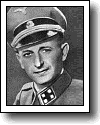 |
Adolf Eichmann (1906-1962) was instrumental in implementing the Final Solution, organizing transports of Jews from all over Europe to the killing centers. As SS lieutenant colonel and head of IVB4, the Jewish department of the Office for Reich Security, Eichmann served as secretary at the Wannsee Conference. He was arrested at the war's end in the American zone of Germany, but escaped to Latin America and disappeared. In 1960, members of the Israeli Secret Service discovered Eichmann in Argentina and through a covert action, transported him to Israel for trial. In December, 1961, Eichmann was sentenced to death and executed in Jerusalem.
 Visit the Remember.org site on the Eichmann trial for more information, transcripts, photographs, and a teacher's guide. Visit the Remember.org site on the Eichmann trial for more information, transcripts, photographs, and a teacher's guide.
|
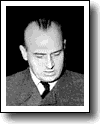 |
Hans Frank (1900-1946) Governor-General of occupied Poland from 1939 to 1945. A member of the Nazi Party from its earliest days and Hitler's personal lawyer, he announced, "Poland will be treated like a colony; the Poles will become slaves of the Greater German Reich." By 1942, more than 85% of the Jews in Poland had been transported to extermination camps. Frank was tried at Nuremberg, convicted, and executed in 1946.
 Hans Frank's' biography from the Encyclopedia of the Holocaust. Hans Frank's' biography from the Encyclopedia of the Holocaust.
|
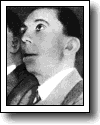 |
Joseph Goebbels (1897-1945)  held the title of Reich Minister for People's Enlightenment and Propaganda from 1933 until his suicide in May, 1945. He had total control of the radio, the press, publishing houses, and the cinema. He was highly skilled at mass persuasion and played an important role in creating and maintaining the Führer's image. He staged the book burning in Berlin in 1933 and instigated Kristallnachtin 1938. held the title of Reich Minister for People's Enlightenment and Propaganda from 1933 until his suicide in May, 1945. He had total control of the radio, the press, publishing houses, and the cinema. He was highly skilled at mass persuasion and played an important role in creating and maintaining the Führer's image. He staged the book burning in Berlin in 1933 and instigated Kristallnachtin 1938.
Joseph Goebbels' biography gives more detail about his life and involvement in Nazi Germany.
 Joseph Goebbels' biography from the Encyclopedia of the Holocaust. Joseph Goebbels' biography from the Encyclopedia of the Holocaust. Photographs of Joseph Goebbels from his teenage years to his death. Photographs of Joseph Goebbels from his teenage years to his death. |
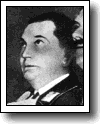 |
Hermann Göring (1893-1946)  was Commander-in-Chief of the Luftwaffe, President of the Reichstag, Prime Minister of Prussia, and Hitler's designated successor. He created the secret police and helped set up the early concentration camps for political opponents. In 1936, as Plenipotentiary for the implementation of the Four Year Plan, he had dictatorial control in directing the German economy, and personally amassed a fortune. Göring directed the Luftwaffe campaigns against Poland, France, and Great Britain. Hitler blamed Göring for Germany's military defeats. Göring was tried at Nuremberg, found guilty and sentenced to death. He committed suicide while in prison. was Commander-in-Chief of the Luftwaffe, President of the Reichstag, Prime Minister of Prussia, and Hitler's designated successor. He created the secret police and helped set up the early concentration camps for political opponents. In 1936, as Plenipotentiary for the implementation of the Four Year Plan, he had dictatorial control in directing the German economy, and personally amassed a fortune. Göring directed the Luftwaffe campaigns against Poland, France, and Great Britain. Hitler blamed Göring for Germany's military defeats. Göring was tried at Nuremberg, found guilty and sentenced to death. He committed suicide while in prison.
 An excellent biography of Hermann Göring is available from the book Who's Who in Nazi Germany. An excellent biography of Hermann Göring is available from the book Who's Who in Nazi Germany. Göring entry from Grolier Online. Göring entry from Grolier Online. An outline of Göring's life from the About.com. An outline of Göring's life from the About.com. |
 |
Rudolf Hess (1894-1987) was the mentally unstable number three man in Hitler's Germany. He is best known for a surprise flight to Scotland in 1941. He was sentenced to life in prison at Nuremberg. He died in jail in 1987.
 A short biography of Rudolf Hess is available at the "History Place." A short biography of Rudolf Hess is available at the "History Place." |
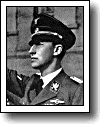 |
Reinhard Heydrich (1904-1942) became the chief of the SD. His more notorious achievements included the establishment of ghettos in Poland, his leadership of the Einsatzgruppen, and the convening of the Wannsee Convention. His assassination in 1942 caused merciless German reprisals, continuing after his death the terror and intimidation that characterized his life.
 Biography of Reinhard Heydrich from the Encyclopedia of the Holocaust. Biography of Reinhard Heydrich from the Encyclopedia of the Holocaust.
 This biography examines Heydrich's role within the Nazi regime. This biography examines Heydrich's role within the Nazi regime. |
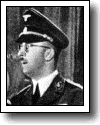 |
Heinrich Himmler (1900-1945)  was an unsuccessful chicken farmer and fertilizer salesman who became a leader in the Nazi party in the mid-1920s. As head of the SS as well as the Gestapo, he was a cold, efficient, ruthless administrator. He was the organizer of the mass murder of Jews, the man in charge of the concentration and death camps. was an unsuccessful chicken farmer and fertilizer salesman who became a leader in the Nazi party in the mid-1920s. As head of the SS as well as the Gestapo, he was a cold, efficient, ruthless administrator. He was the organizer of the mass murder of Jews, the man in charge of the concentration and death camps.
|
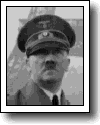 |
Adolf Hitler (1889-1945)  was leader of the Nazi Party and Reich Chancellor of the Third Reich from 1933 to 1945. His tyrannical reign was marked with a passion for destruction, ruthless hatred, and the massacre of millions of innocent people. was leader of the Nazi Party and Reich Chancellor of the Third Reich from 1933 to 1945. His tyrannical reign was marked with a passion for destruction, ruthless hatred, and the massacre of millions of innocent people.
|
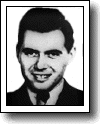 |
Joseph Mengele (1911-1978?) SS - physician at Auschwitz, notorious for pseudo-medical experiments, especially on twins and Gypsies. He "selected" new arrivals by simply pointing to the right or the left, thus separating those considered able to work from those who were not. Those too weak or too old to work were sent straight to the gas chambers, after all their possessions, including their clothes, were taken for resale in Germany. After the war, he spent some time in a British internment hospital but disappeared, went underground, escaped to Argentina, and later to Paraguay, where he became a citizen in 1959. He was hunted by Interpol, Israeli agents, and Simon Wiesenthal. In 1986, his body was found in Embu, Brazil.
 An outline biography of Joseph Mengele from About.com. An outline biography of Joseph Mengele from About.com.
|
 |
Jürgen Stroop (1895-1951) was the SS major general responsible for the destruction of the Warsaw ghetto in 1943. Later that year, as Higher SS and Police Leader in Greece, he supervised the deportation of thousands of Jews from Salonika. He was sentenced to death and executed in Poland in 1951. Excerpts from General Stroop's report on the destruction of the Warsaw Ghetto.
Visit the Resource section to view photographs of Nazi leaders Visit the Resource section to view photographs of the defendants at the Nuremberg Trials. Visit the Resource section to view photographs of the defendants at the Nuremberg Trials.  Many photographs related to the Nuremberg Trials from the Wiesenthal Center site.
Interactive quiz on Perpetrators. Many photographs related to the Nuremberg Trials from the Wiesenthal Center site.
Interactive quiz on Perpetrators.  Lesson plans, discussion questions, term paper topics, reproducible handouts, and other resources for teaching about perpetrators are available here. Lesson plans, discussion questions, term paper topics, reproducible handouts, and other resources for teaching about perpetrators are available here.
|
|
|
|
|
|
|
| |
Heute waren schon 15 visitors (18 hits) hier! |
|
|
|
|
|
|
|


 Hitler, a highly skilled orator, spoke at a number of mass rallies. These mass meetings created a sense of community, kept emotional levels high, and were a psychologically fertile environment in which to deliver propaganda. Rallies often took place in the evening when Hitler thought that people were most suggestible and least resistant. Carefully timed stage effects including: marching music, spotlights, torchlight processions, parades, flags fluttering, shouts of "Heil!," and impassioned oratory created the feeling of national unity, strength, and purpose.
Hitler, a highly skilled orator, spoke at a number of mass rallies. These mass meetings created a sense of community, kept emotional levels high, and were a psychologically fertile environment in which to deliver propaganda. Rallies often took place in the evening when Hitler thought that people were most suggestible and least resistant. Carefully timed stage effects including: marching music, spotlights, torchlight processions, parades, flags fluttering, shouts of "Heil!," and impassioned oratory created the feeling of national unity, strength, and purpose. Concentration camps were a part of the perpetrators' systematic reign of terror. The SA and the SS units, during the first months following the Nazi seizure of power, established the camp at Dachau in March, 1933. Initially, Communists, Socialists, labor leaders, and other political opponents were the prisoners. Jews and homosexuals were sent next. By 1934, a unit of the SS, named the Death's Head Formations, was in charge of all the concentration camps. Prisoners were starved, forced into labor, tortured, and sometimes murdered in these camps.
Concentration camps were a part of the perpetrators' systematic reign of terror. The SA and the SS units, during the first months following the Nazi seizure of power, established the camp at Dachau in March, 1933. Initially, Communists, Socialists, labor leaders, and other political opponents were the prisoners. Jews and homosexuals were sent next. By 1934, a unit of the SS, named the Death's Head Formations, was in charge of all the concentration camps. Prisoners were starved, forced into labor, tortured, and sometimes murdered in these camps.








